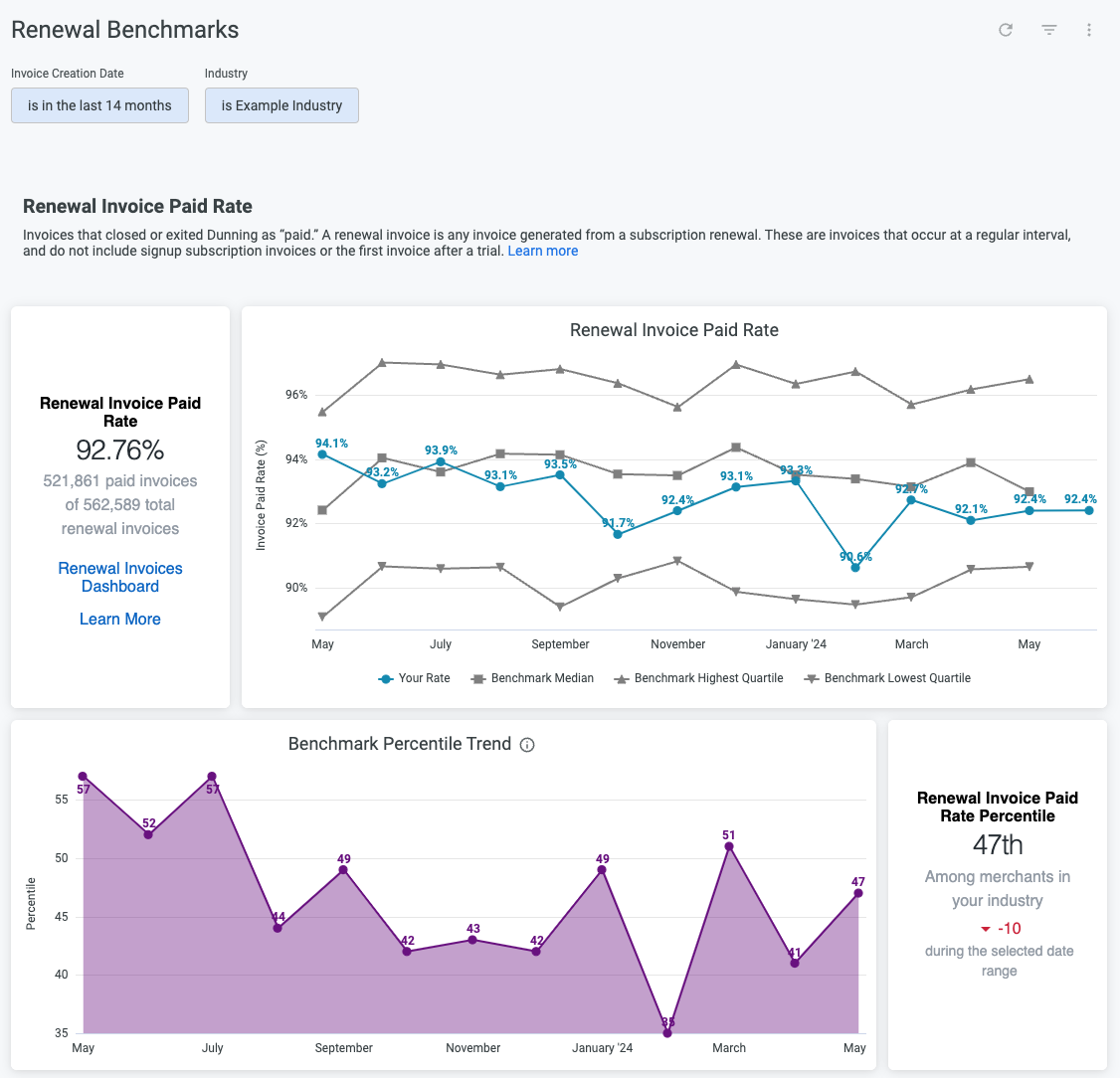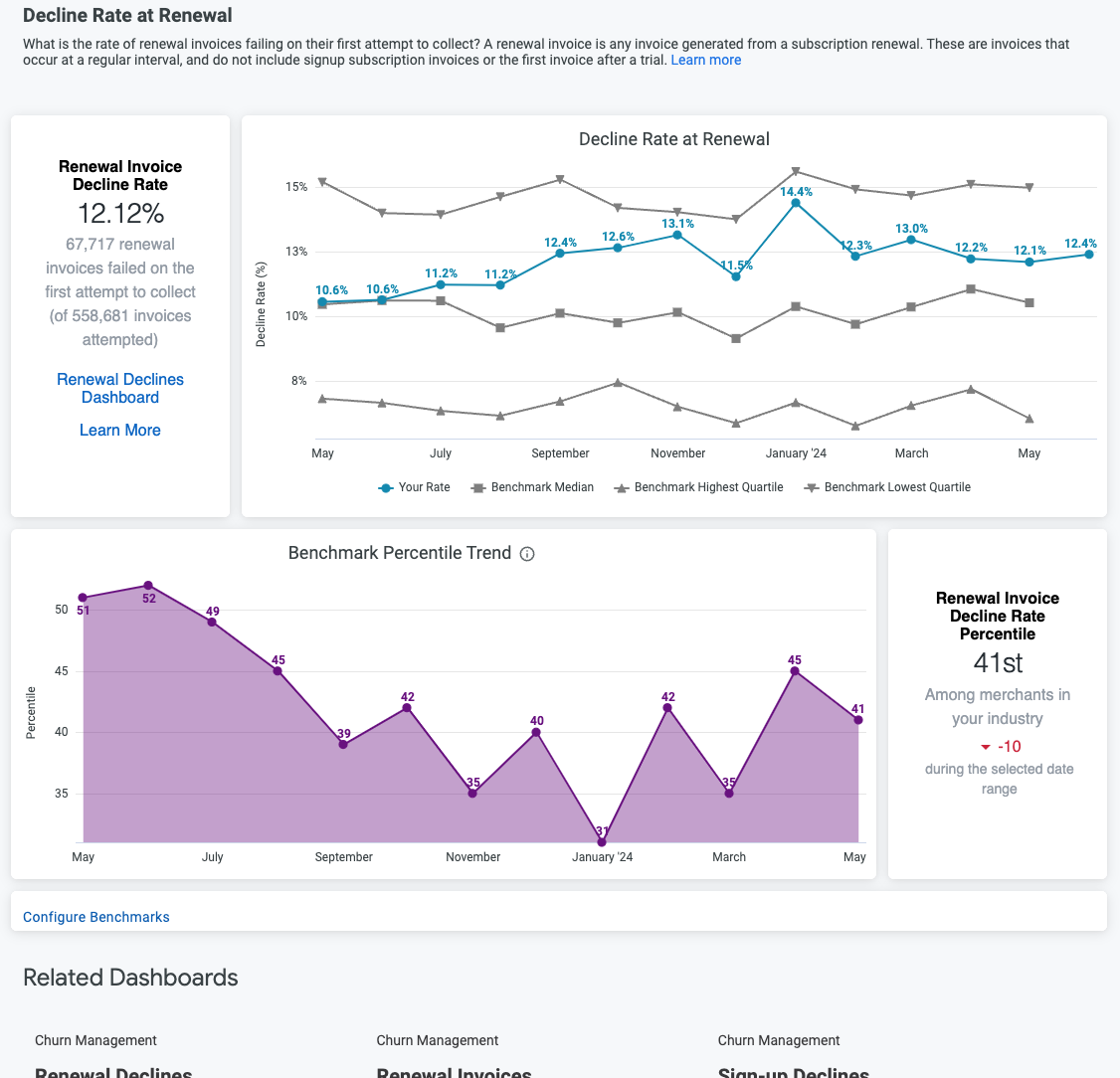Renewal benchmarks
The Renewal Benchmarks dashboard will provide insights on your renewal invoice success and decline rates, benchmarked against those in your industry.
Overview
Required plan
This feature or setting is available to all customers on any Recurly subscription plan.
Prerequisites
- Users must have analytics user role permission.
Definition
The renewal benchmarks will provide insights on your overall renewal invoices as well as provide detail into the decline reasons for renewal invoices.
Key benefits
- Industry comparison: Compare key subscription metrics with industry benchmarks to understand performance relative to peers, identifying areas of strengths and weaknesses.
- Competitive insights: Gain insights into how competitors are faring in terms of subscription metrics, uncovering areas to differentiate and improve to gain a competitive edge.
- Informed decision-making: Make informed decisions based on real-world data to help set realistic goals and expectations for subscription growth and customer retention.
- Forecasting and planning: Enable more accurate forecasting and long-term planning to help businesses set reachable growth targets and allocate resources effectively.
Key details
General filters (Top left corner)
-
Invoice Date range: Allows you to specify the time period of invoices to review.
-
Industry: Allows you to change between different industries to review the benchmark information, and will default to your configured industry.
Renewal invoice benchmarks
The Renewal Invoices Benchmarks offer insights into the performance of renewal invoices, both those that are successfully paid and those that fail on the first transaction attempt.
Your ranking in this area is presented as a percentile, comparing your performance to that of peers in your industry. Monitoring your percentile trend over time can provide valuable insights into how your renewal strategy performs relative to the broader industry standards.

Renewal invoice paid rate calculation
This calculation shows the percentage of renewal invoices created within a certain period that are successfully paid (marked as "paid") out of the total number of renewal invoices issued.
- Example: In April, if 1,000 renewal invoices are issued and 750 are paid, the initial paid rate is 75%. If, after two weeks, another 150 invoices are settled following dunning efforts, the revised invoice paid rate reaches 90%.
Calculations are based on the “invoice creation date” to ensure consistency.

Renewal decline rate calculation
This calculation shows the percentage of renewal invoices that are not successfully paid on the first attempt.
Your position within your industry is represented as a percentile, showing where you stand compared to others. Tracking your percentile over time helps you understand how your renewal process compares and evolves in the context of your industry.
- Initial transactions: These are the very first attempts to process a payment on an invoice, highlighting the importance of the initial interaction.
- Reason for focusing on first transaction: This approach ensures a fair comparison across businesses, regardless of their policies on retrying invoice payments. It's about ensuring consistency and comparability.
The evaluation period is determined by the date of the initial transaction on the invoice.
Your position within your industry is represented as a percentile, showing where you stand compared to others. Tracking your percentile over time helps you understand how your renewal process compares and evolves in the context of your industry.
FAQs
What is a Renewal Invoice?
A renewal invoice refers to an invoice that is issued as part of a subscription's regular renewal process. This includes any invoices that are generated at the set intervals following the initial signup or the first invoice after a trial period. Essentially, renewal invoices represent the recurring billing aspect of a subscription, excluding the initial acquisition or trial conversion invoices.
Updated 3 days ago
